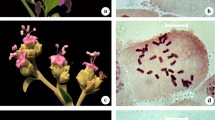Abstract
The genus Phlogacanthus Nees belongs to the family Acanthaceae and is represented by herbs or shrubs species. The present work shows detailed karyomorphological studies in two species, Phlogacanthus quadrangularis (Hook.) Heine and Phlogacanthus guttatus Nees. Both the species grow as undergrowth vegetation. The conservation status of both the species are yet to be determined. The somatic chromosome counts of both the mentioned species are available for the first time, 2n = 40 for P. quadrangularis and 2n = 34 for P. guttatus. The karyomorphological observations showed that both plant species show dominance of sub-telocentric chromosomes with a few metacentric chromosomes. P. quadrangularis have telocentric chromosomes which is absent in the other species. The range of length of chromosomes in P. quadrangularis is from 0.340 μm to 1.32 μm and that of P. guttatus is from 0.560 μm to 1.878 μm. The karyotype type of the two species are classified as 3B type. But the dispersion index (DI) value of both the species are different. P. guttatus shows higher value of DI than P. quadrangularis. Higher the DI value more specialized is the karyotype. By comparing the chromosome length, size, DI value and idiogram of both the species, it is concluded that the karyotype of P. guttatus is more asymmetric and advanced than karyotype of P. quadrangularis. The karyomorphological findings of the present study will aid in determining the importance and utility, ex-situ conservation, protection, preservation and regeneration of germplasm.


Similar content being viewed by others
References
Baishya A. K. 1999 Assam. In Floristic diversity and conservation strategies in India. Botanical Survey of India, Calcutta. 2, 615–662.
Barooah C. and Ahmed I. 2014 Plant diversity of Assam – a checklist of angiosperms and gymnosperms. Assam Science Technology and Environment Council, Guwahati.
Boro N. and Das B.N. 2019 Karyomorphological studies in three species of the genus Phlogacanthus Nees occurring in Assam. Indian J. Genet. Plant Breed. 79, 507–510.
Daniel T. F. 2000 Additional chromosome numbers of American Acanthaceae. Syst. Bot. 25, 15–25.
Das A. B., Mohanty S. and Das P. 1998 Variation in karyotype and 4C DNA content in six species of Melocactus of the family Cactaceae. Cytologia 63, 133–139.
Das B. N. 2018 Karyomorphological studies in three species of Alocasia (Schott.) G.Don.- an ethno-medicinally and economically important genus. Int. J. Life Sci. Sci. Res. 4, 2116–2121.
Deb B. 1983 The flora of Tripura state. Today and Tomorrow’s Printers and Publishers, Howrah.
Dutta B., Sharma J. and Borthakur S. K. 2016 Diversity and ethnobotany of the genus Phlogacanthus Nees in Assam, India. Int. J. Life Sci. Sci. Res. 2, 472–477
Huziwara Y. 1962 Karyotype analysis in some genera of Compositae VIII. Future studies on the chromosome of Aster. Am. J. Bot. 49, 116–119
Kanjilal U. N., Das A., Kanjilal P. C., De R. E. 1939 Flora of Assam, vol. III, pp. 441–445. Government of Assam, Kolkata.
Khosla M. K. and Sobti S. N. 1985 Karyomorphological studies in genus Ocimum II. Sanctum group. Cytologia 50, 253–263.
Lavania U. C. and Srivastava S. 1992 A simple parameter of dispersion index that serves as an adjunct to karyotype asymmetry. J. Biosci. 17, 179–182.
Levan A. Fredga K. and Sanderberg A. A. 1964 Nomenclature for centromeric position on chromosomes. Hereditas 52, 201–220.
Nabis B. 2007 Cytogenetics of Plumbgo Linn.: studies on karyomorphological and nuclear DNA content in certain species. Ph.D. thesis, Gauhati University, Guwahati, India.
Sharma A. K. and Sharma A. 1980 Chromosome techniques: theory and practice, 3rd edition. Butterworths, London.
Stebbins G. L. 1971 Chromosome evolution in higher plants. Edward Arnold Publishers, London.
Acknowledgements
I express my heartful thanks to ASTEC (Assam Science Technology and Environment Council) (Grant No. ASTEC/S&T/192(164)/2017-18/844), Guwahati, for funding a minor research project under Ph.D. work.
Author information
Authors and Affiliations
Corresponding author
Additional information
Corresponding editor: Manoj Prasad
Rights and permissions
About this article
Cite this article
Boro, N., Das, B.N. Karyomorphology in two species of the genus Phlogacanthus Nees of Assam: some new karyological insights. J Genet 99, 76 (2020). https://doi.org/10.1007/s12041-020-01237-3
Received:
Revised:
Accepted:
Published:
DOI: https://doi.org/10.1007/s12041-020-01237-3




